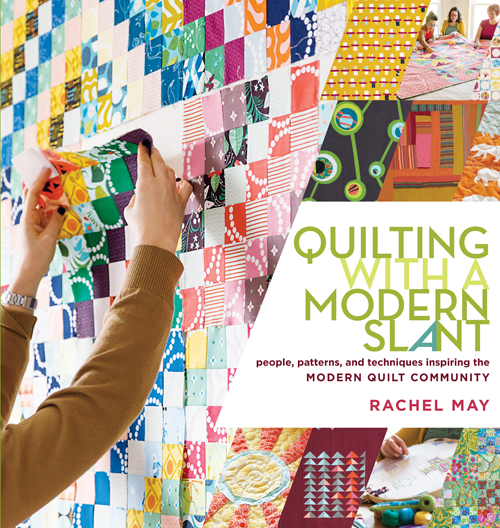I have long been wary of the term “modern.” I have been writing and talking about its problematic nature just about as long as I have been quilting. Certainly I am a big supporter of the modern quilt community; it’s just that I’m wary of the word. And it is through that word that I enter into reading Rachel May’s new book: Quilting with a Modern Slant.
It is a word that seems ubiquitous; heck, it even slipped into the title of my book as it went the rounds of marketing and PR departments. It is a word that I think Rachel approaches very sensitively, as is shown in the way it becomes exceptionally adjectival: it is not a book about Modern Quilts; it is a book about quilting as seen through the emergence of the modern quilt community. The title resists any possibility of a monolithic definition of modern, and then the book follows through on that titular promise. Rather than illustrate modern quilting, Rachel demonstrates just how diverse the community is, just how eclectic the influences and attitudes are. Yes, Rachel presents a view of modern quilting, but that view is more a reflection than an encapsulation.
Now perhaps I am a little bit biased (I am in the book after all), but I think Rachel is offering something profoundly significant with this book. As the appeal of modern has expanded in the quilting world, the desire to capitalize on it has exploded. But to be marketable it had to become in some way coherent, have representative features: bright colors, lots of solids, big shapes, etc, etc… Over time, modern has drawn dangerously close to being little more than an empty signifier, a term that lacks any real substance, or at least a significant connection to the incredibly diverse practice it is meant to convey.
Quilting with a Modern Slant is an antidote to the marketing of modern. It demonstrates the complex and often contradictory nature of the modern quilt community. This book has very little to do with being “on trend,” and everything to do with substance. Rather than focus on the what and the how, Quilting with a Modern Slant dives deep into the question of why? And rather than offer a singular answer, it provides scores of possible answers. And while the many voices of this book provide a wide range of inspiration and perspective, what I find most compelling is the fact that in doing so it encourages readers (and makers) to explore their own perspectives.
And in the end, that is truly Rachel’s gift to us in this book: she opens up a space in which we can explore just what quilting means to us today. It’s not so important to pin down exactly what modern means, but it is significant to recognize that something different is happening now, that the impulse to quilt in the 21st century is an impulse worthy of investigation. And throughout Quilting with a Modern Slant, Rachel offers that anthropological eye as she weaves together a remarkable perspective on the recent revival of quilting.
At the same time, I keep returning to the first words of the introduction: “Most of the people in this book began quilting on a whim.” These words not only remind us that modern quilting is not a singular vision, they remind us of the basic joy of the practice of quilting, a joy that filters through the entire book. Ultimately, this book is about Rachel’s love of quilting, her passion for the practice and the people she shares this community with. In offering such a diverse and extraordinary perspective on the modern quilt community, Rachel implores us to look beneath the surface of modern to see the incredibly rich practice that is emerging all across the quilting community.
So, thank you, Rachel, for including me in your book. I am both honored and flattered, and I could not be happier for you and the well-deserved success this book is having. Congratulations and kudos…
-t










4 Responses to Quilting with a Modern Slant…